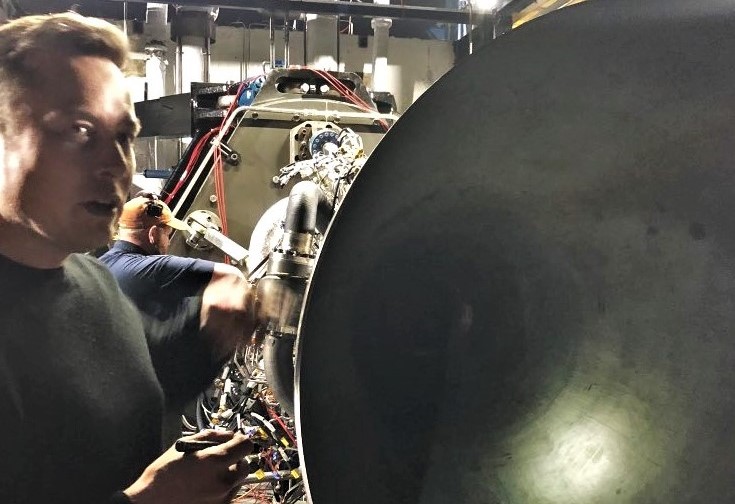
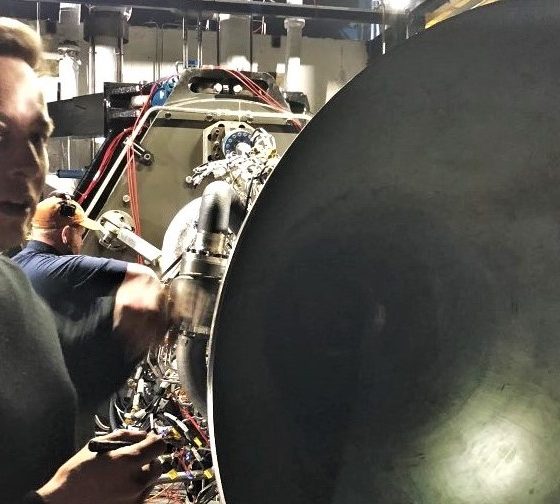
News
SpaceX CEO Elon Musk arrives in Texas for milestone Starship engine test
On Saturday evening, SpaceX CEO Elon Musk landed in Waco, Texas – perhaps along with additional SpaceX propulsion engineers – for the critical static fire debut of the first “radically redesigned” Raptor engine, built to power BFR’s Starship upper stage and Super Heavy booster.
If the first operationalized Raptor’s static fire tests go well, there are several possible routes the test program could take, all of which will end up with this engine and several others being tested and ultimately installed on the Starship hopper (Starhopper) prototype under construction roughly 500 miles (800 km) south of SpaceX’s Raptor test cell.
At @SpaceX Texas with engineering team getting ready to fire new Raptor rocket engine pic.twitter.com/ACFM8AtY8w
— Elon Musk (@elonmusk) February 3, 2019
Shortly after Musk revealed official photos of the first operationalized Raptor preparing for an inaugural static fire test at SpaceX’s McGregor, Texas facilities, the SpaceX and Tesla CEO’s private jet was seen landing at Waco, Texas around sunset. Although all SpaceX technical expertise needed for Raptor’s first ignition was probably already on site several days prior, Musk has been known to offer seats on his private planes to SpaceX and Tesla employees when a critical group is needed away from their normal base of operations. The best examples come from Tesla engineering expertise sometimes traveling between Fremont and Gigafactory 1 when needed, often to solve production holdups.
Regardless of whether he was traveling with members of the SpaceX propulsion team, Musk’s arrival at McGregor yesterday signified that Raptor Block 1’s first integrated hot-fire was imminent. Assuming no attempt was made on Saturday night or Sunday morning, SpaceX technicians and engineers are presumably still working on installing what is effectively a new rocket engine and ensuring that Raptor’s test cells – extensively overhauled and upgraded for the occasion – are working as intended. While the development Raptors SpaceX built hovered around 1000 kN (~100t) of thrust, also roughly the same as Merlin 1D, the Raptor now on stand in Texas is reportedly a 200 ton-class engine or more than double the thrust of any single engine SpaceX engineers and technicians have built or test-fired in 15 years of engine development.
- The only official render of Raptor, published by SpaceX in September 2016. The Raptor departing Hawthorne in Jan ’19 looked reasonably similar. (SpaceX)
- Technically speaking, this Raptor is the smaller (sea-level) version of the engine. (SpaceX)
- SpaceX’s current Texas facilities feature a test stand for Raptor, the engine intended to power BFR and BFS to Mars. (SpaceX)
- A Raptor prototype is seen here during its first-ever ignition test. (SpaceX)
- A 2017 test-firing of the mature development Raptor, roughly 50% less powerful than the full-scale system. (SpaceX)
A fork in the R&D road
Prior to completing Raptor Block 1 (unofficial designation), SpaceX cumulatively test-fired dev Raptors for far more than 1200 seconds over the course of more than 24 months. It’s unclear how extensively the company’s engineers will be able to test the pathfinder hardware built on the back of that extensive test program. Nominally, one would expect hundreds or thousands of seconds of additional testing to properly characterize the design and production of a brand-new, optimized engine like Raptor while primarily ensuring that it performs within engineering specifications.
Knowing CEO Elon Musk’s self-admitted tendency to push for impractical deadlines and schedules that often appeared rushed for the sake of rushing, it’s not impossible that the first Raptors could find themselves installed on the Boca Chica-based Starhopper test article after Merlin-esque acceptance testing and nothing more. For M1D and MVac, acceptance testing usually takes the shape of a full-duration burn with throttle and gimbal activity to closely simulate a true Falcon 9 or Heavy launch. For the 200-ton Raptor now in Texas, comparable acceptance testing could take a variety of forms, ranging from short Starhopper-relevant burns (10-60 seconds for small hops) to simulating conditions during a Super Heavy launch and landing or even a 6 or 7-minute orbital insertion burn indicative of the performance needed for Starship.

Depending on the interplay between the route SpaceX engineers would likely prefer and the Starhopper test schedule executives and managers might want, this first Raptor engine (and two more soon to follow) could be installed on Starhopper anywhere from a few weeks to several months from now. Elon Musk indicated in early January that he expected hop tests would occur 4-8 weeks later, shortly followed by unplanned damage to the craft’s nose cone that pushed the debut back “a few weeks”.
Aiming for 4 weeks, which probably means 8 weeks, due to unforeseen issues
— Elon Musk (@elonmusk) January 5, 2019
I just heard. 50 mph winds broke the mooring blocks late last night & fairing was blown over. Will take a few weeks to repair.
— Elon Musk (@elonmusk) January 23, 2019
Realistically, hop tests should thus be expected to begin no earlier than (NET) 8-12 weeks from the first week of January, translating to NET March or April. This would give SpaceX propulsion engineers a decent amount of time to gain at least a few hundred (or maybe 1000+) seconds of experience operating the newest and most advanced iteration of Raptor.
Check out Teslarati’s newsletters for prompt updates, on-the-ground perspectives, and unique glimpses of SpaceX’s rocket launch and recovery processes!

Elon Musk
SpaceX Starship Version 3 booster crumples in early testing
Photos of the incident’s aftermath suggest that Booster 18 will likely be retired.

SpaceX’s new Starship first-stage booster, Booster 18, suffered major damage early Friday during its first round of testing in Starbase, Texas, just one day after rolling out of the factory.
Based on videos of the incident, the lower section of the rocket booster appeared to crumple during a pressurization test. Photos of the incident’s aftermath suggest that Booster 18 will likely be retired.
Booster test failure
SpaceX began structural and propellant-system verification tests on Booster 18 Thursday night at the Massey’s Test Site, only a few miles from Starbase’s production facilities, as noted in an Ars Technica report. At 4:04 a.m. CT on Friday, a livestream from LabPadre Space captured the booster’s lower half experiencing a sudden destructive event around its liquid oxygen tank section. Post-incident images, shared on X by @StarshipGazer, showed notable deformation in the booster’s lower structure.
Neither SpaceX nor Elon Musk had commented as of Friday morning, but the vehicle’s condition suggests it is likely a complete loss. This is quite unfortunate, as Booster 18 is already part of the Starship V3 program, which includes design fixes and upgrades intended to improve reliability. While SpaceX maintains a rather rapid Starship production line in Starbase, Booster 18 was generally expected to validate the improvements implemented in the V3 program.
Tight deadlines
SpaceX needs Starship boosters and upper stages to begin demonstrating rapid reuse, tower catches, and early operational Starlink missions over the next two years. More critically, NASA’s Artemis program depends on an on-orbit refueling test in the second half of 2026, a requirement for the vehicle’s expected crewed lunar landing around 2028.
While SpaceX is known for diagnosing failures quickly and returning to testing at unmatched speed, losing the newest-generation booster at the very start of its campaign highlights the immense challenge involved in scaling Starship into a reliable, high-cadence launch system. SpaceX, however, is known for getting things done quickly, so it would not be a surprise if the company manages to figure out what happened to Booster 18 in the near future.
News
Tesla FSD (Supervised) is about to go on “widespread” release
In a comment last October, Elon Musk stated that FSD V14.2 is “for widespread use.”
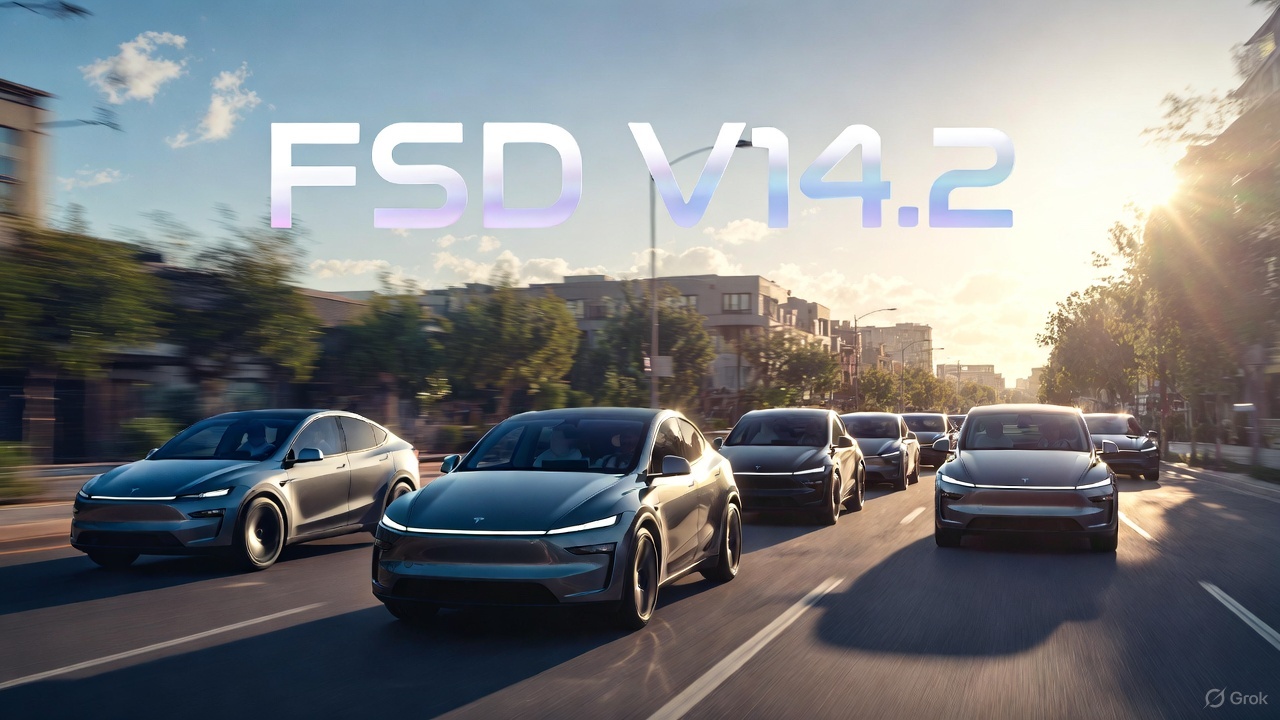
Tesla has begun rolling out Full Self-Driving (Supervised) V14.2, and with this, the wide release of the system could very well begin.
The update introduces a new high-resolution vision encoder, expanded emergency-vehicle handling, smarter routing, new parking options, and more refined driving behavior, among other improvements.
FSD V14.2 improvements
FSD (Supervised) V14.2’s release notes highlight a fully upgraded neural-network vision encoder capable of reading higher-resolution features, giving the system improved awareness of emergency vehicles, road obstacles, and even human gestures. Tesla also expanded its emergency-vehicle protocols, adding controlled pull-overs and yielding behavior for police cars, fire trucks, and ambulances, among others.
A deeper integration of navigation and routing into the vision network now allows the system to respond to blocked roads or detours in real time. The update also enhances decision-making in several complex scenarios, including unprotected turns, lane changes, vehicle cut-ins, and interactions with school buses. All in all, these improvements should help FSD (Supervised) V14.2 perform in a very smooth and comfortable manner.
Elon Musk’s predicted wide release
The significance of V14.2 grows when paired with Elon Musk’s comments from October. While responding to FSD tester AI DRIVR, who praised V14.1.2 for fixing “95% of indecisive lane changes and braking” and who noted that it was time for FSD to go on wide release, Musk stated that “14.2 for widespread use.”
FSD V14 has so far received a substantial amount of positive reviews from Tesla owners, many of whom have stated that the system now drives better than some human drivers as it is confident, cautious, and considerate at the same time. With V14.2 now rolling out, it remains to be seen if the update also makes it to the company’s wide FSD fleet, which is still populated by a large number of HW3 vehicles.
News
Tesla FSD V14.2 starts rolling out to initial batch of vehicles
It would likely only be a matter of time before FSD V14.2 videos are posted and shared on social media.
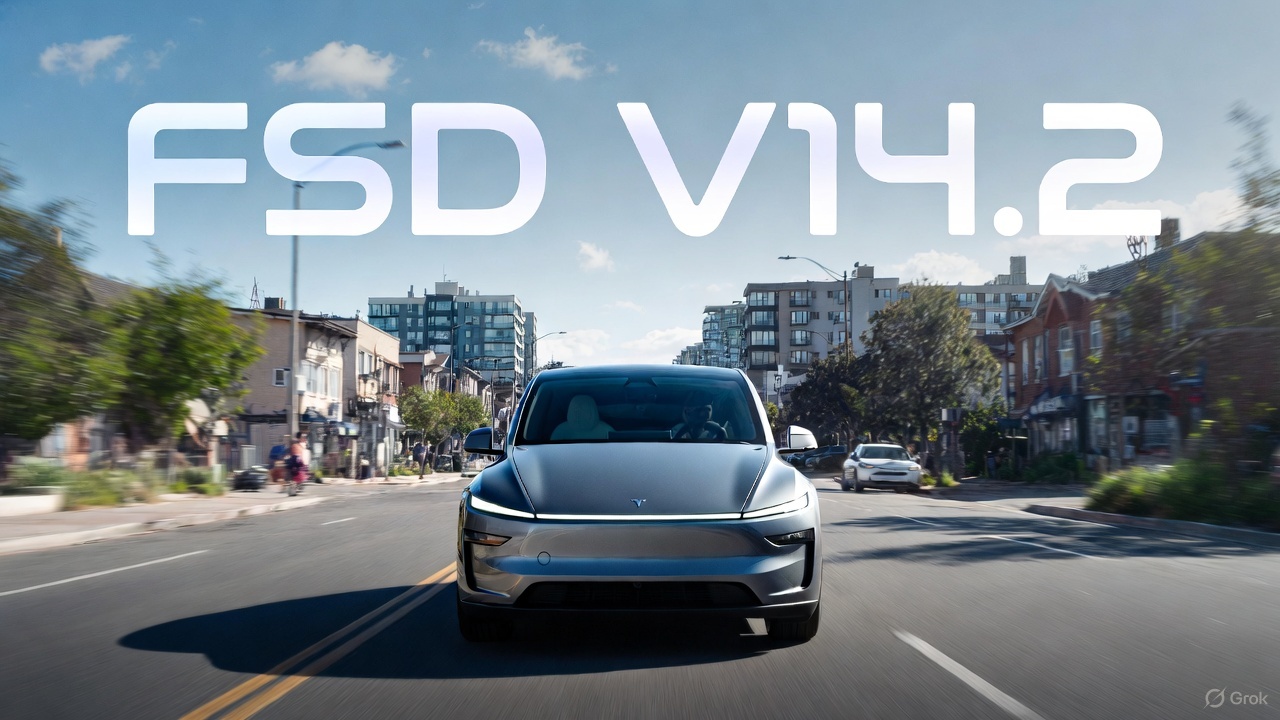
Tesla has begun pushing Full Self-Driving (Supervised) v14.2 to its initial batch of vehicles. The update was initially observed by Tesla owners and veteran FSD users on social media platform X on Friday.
So far, reports of the update have been shared by Model Y owners in California whose vehicles are equipped with the company’s AI4 hardware, though it would not be surprising if more Tesla owners across the country receive the update as well.
Based on the release notes of the update, key improvements in FSD V14.2 include a revamped neural network for better detection of emergency vehicles, obstacles, and human gestures, as well as options to select arrival spots.
It would likely only be a matter of time before FSD V14.2 videos are posted and shared on social media.
Following are the release notes of FSD (Supervised) V14.2, as shared on X by longtime FSD tester Whole Mars Catalog.
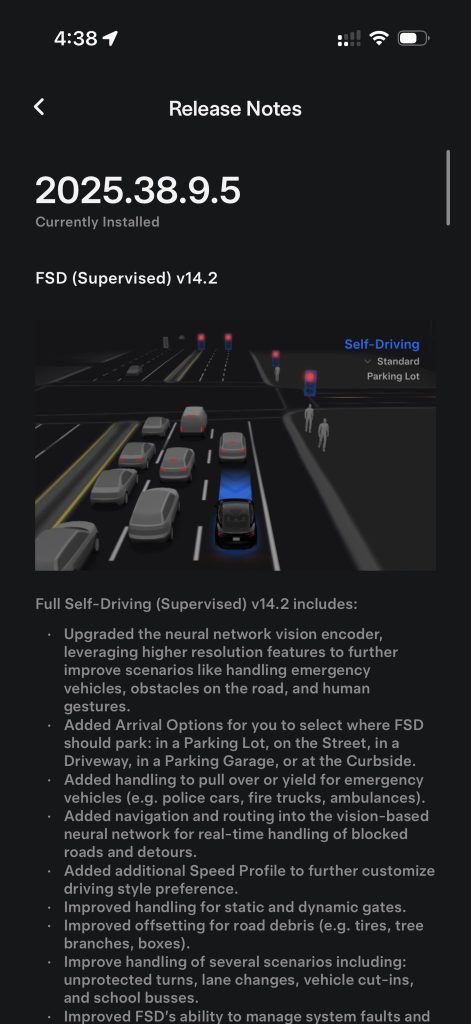
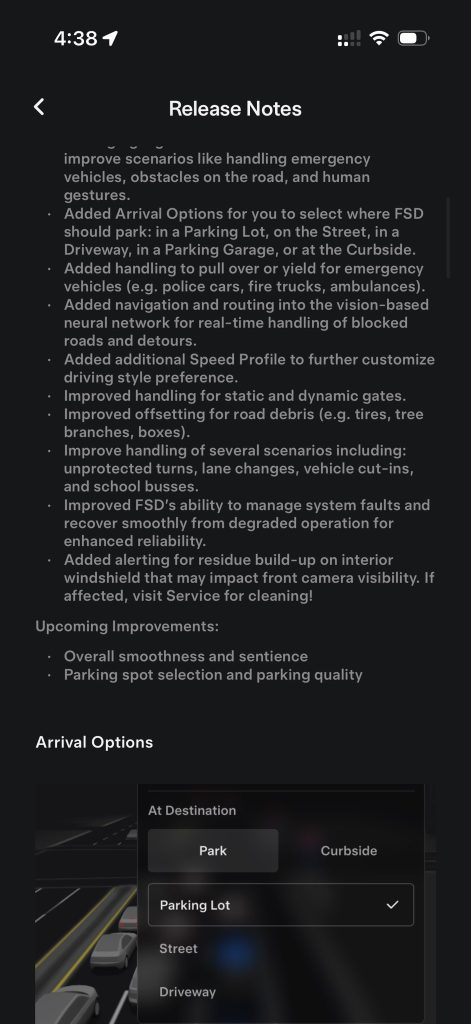
Release Notes
2025.38.9.5
Currently Installed
FSD (Supervised) v14.2
Full Self-Driving (Supervised) v14.2 includes:
- Upgraded the neural network vision encoder, leveraging higher resolution features to further improve scenarios like handling emergency vehicles, obstacles on the road, and human gestures.
- Added Arrival Options for you to select where FSD should park: in a Parking Lot, on the Street, in a Driveway, in a Parking Garage, or at the Curbside.
- Added handling to pull over or yield for emergency vehicles (e.g. police cars, fire trucks, ambulances.
- Added navigation and routing into the vision-based neural network for real-time handling of blocked roads and detours.
- Added additional Speed Profile to further customize driving style preference.
- Improved handling for static and dynamic gates.
- Improved offsetting for road debris (e.g. tires, tree branches, boxes).
- Improve handling of several scenarios including: unprotected turns, lane changes, vehicle cut-ins, and school busses.
- Improved FSD’s ability to manage system faults and improve scenarios like handling emergency vehicles, obstacles on the road, and human gestures.
- Added Arrival Options for you to select where FSD should park: in a Parking Lot, on the Street, in a Driveway, in a Parking Garage, or at the Curbside.
- Added handling to pull over or yield for emergency vehicles (e.g. police cars, fire trucks, ambulances).
- Added navigation and routing into the vision-based neural network for real-time handling of blocked roads and detours.
- Added additional Speed Profile to further customize driving style preference.
- Improved handling for static and dynamic gates.
- Improved offsetting for road debris (e.g. tires, tree branches, boxes).
- Improve handling of several scenarios, including unprotected turns, lane changes, vehicle cut-ins, and school buses.
- Improved FSD’s ability to manage system faults and recover smoothly from degraded operation for enhanced reliability.
- Added alerting for residue build-up on interior windshield that may impact front camera visibility. If affected, visit Service for cleaning!
Upcoming Improvements:
- Overall smoothness and sentience
- Parking spot selection and parking quality













